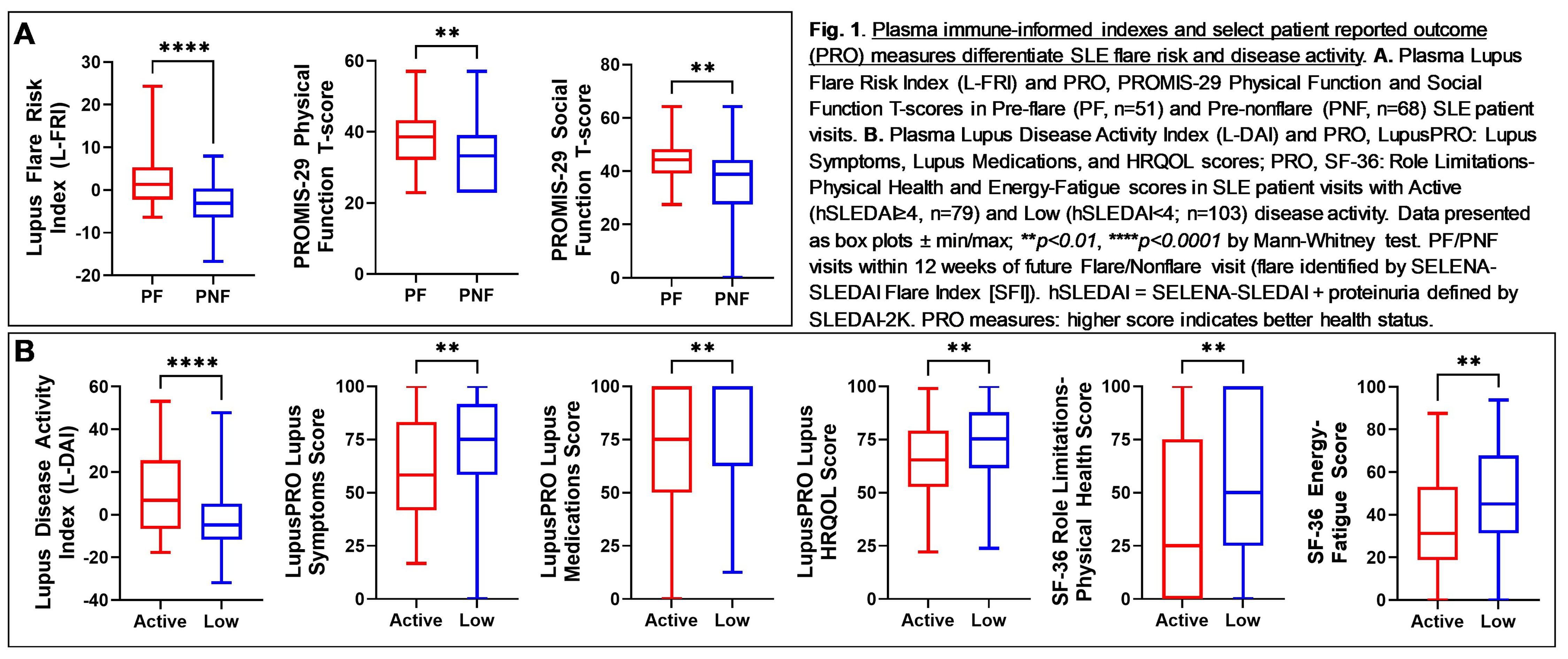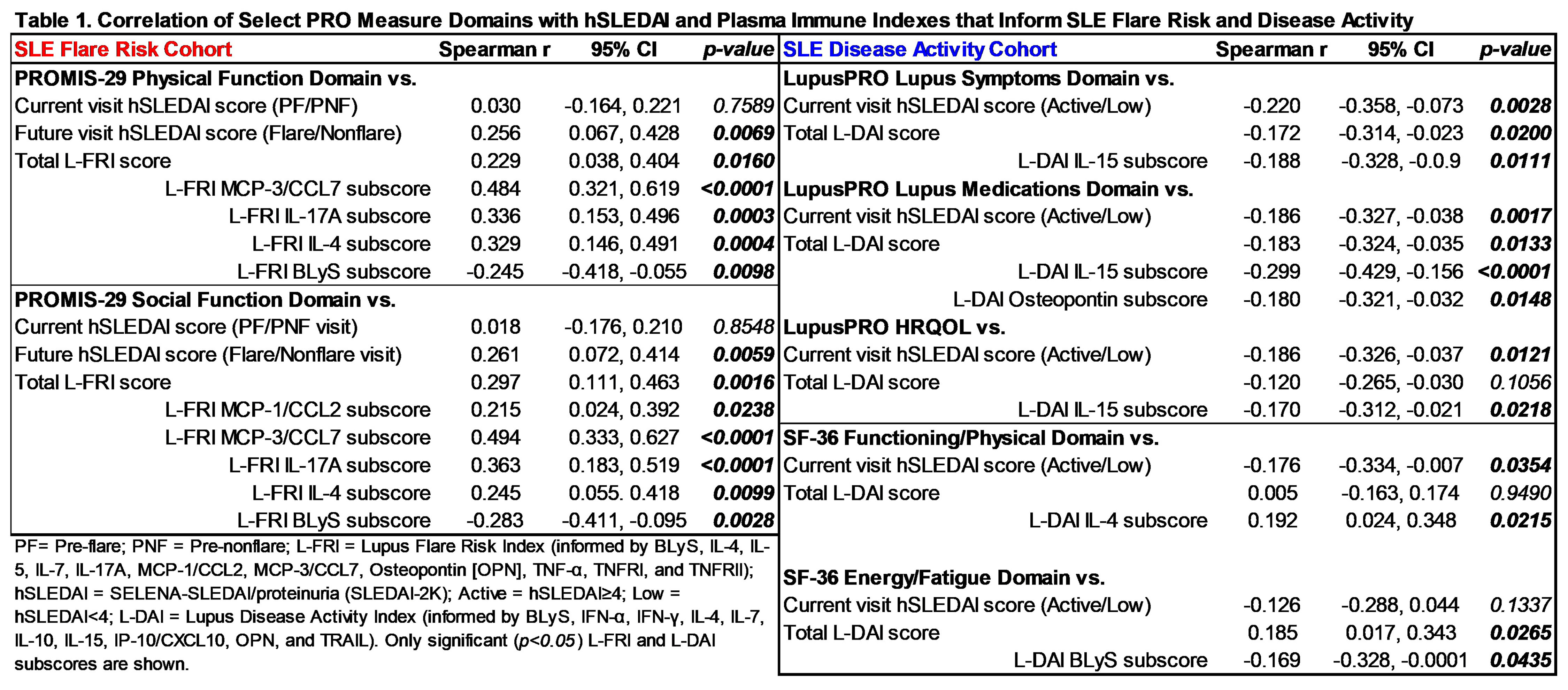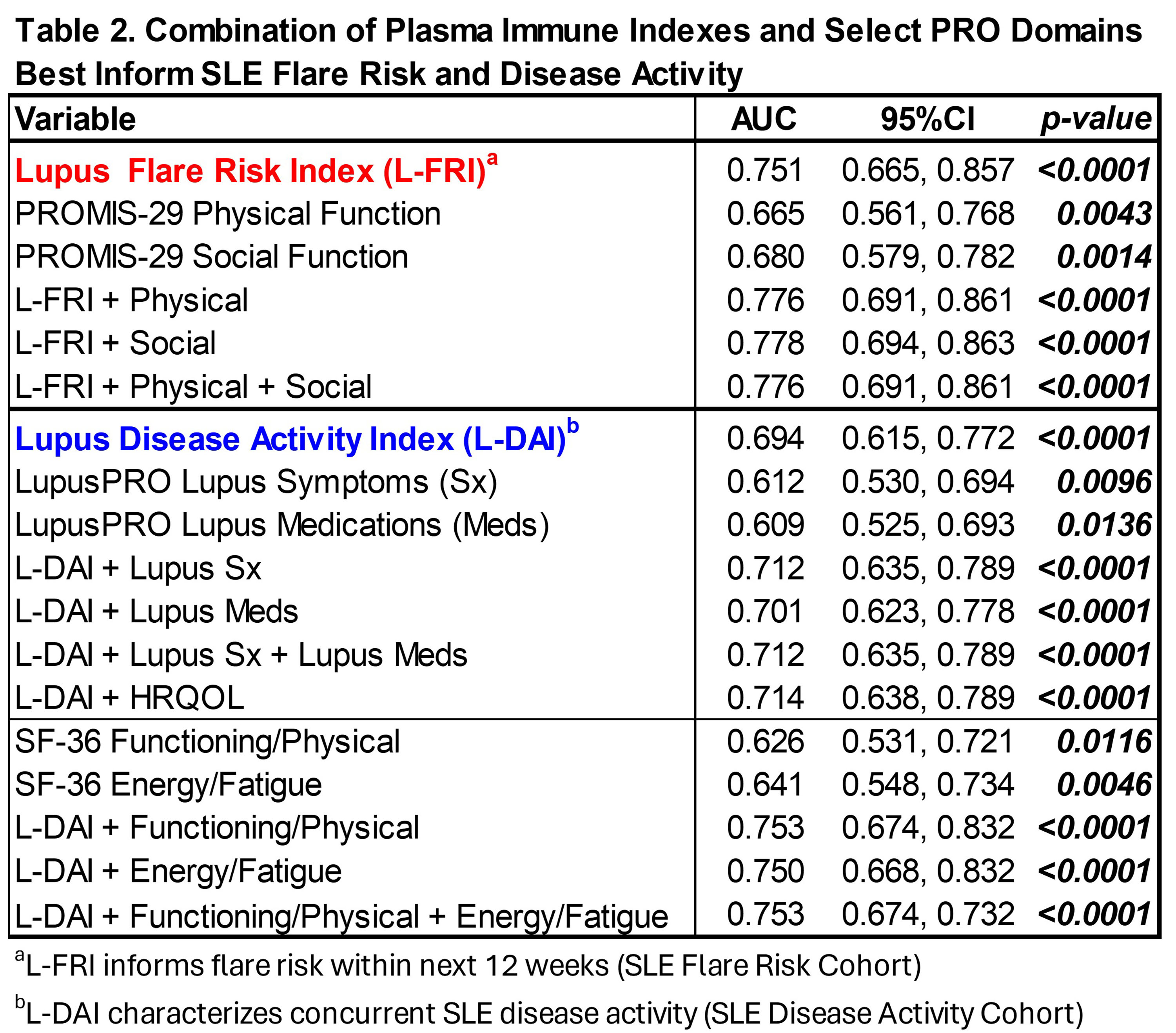Session Information
Session Type: Poster Session A
Session Time: 10:30AM-12:30PM
Background/Purpose: We have recently validated a plasma Lupus Flare Risk Index (L-FRI; Munroe et al. Ann Rheum Dis. 2024. 83 [Supp 1]: 402) and Lupus Disease Activity Index (L-DAI; Munroe et al. Ann Rheum Dis. 2024. 83 [Supp 1]: 19), that reflect altered immunity associated with flare risk and current clinical disease activity, respectively. This study seeks to determine the potential role of select patient reported outcomes (PROs) to enhance the performance of the L-FRI and L-DAI as screening tools.
Methods: We compared domains in PROMIS-29 (v2.0), LupusPRO (v1.7), and SF-36 (v1.0) data available for 51 Pre-flare (PF) vs. 68 Pre-nonflare (PNF) visits in the SLE Flare Risk Cohort and 79 active disease (hSLEDAI≥4) vs. 103 low disease activity (hSLEDAI< 4) visits in the SLE Disease Activity Cohort that respectively informed the L-FRI and L-DAI. The L-FRI is the sum of 11 log-transformed, standardized immune mediators, weighted by the Spearman r correlation coefficient for each PF/PNF analyte vs. subsequent flare/nonflare hSLEDAI disease activity. The L-DAI is the sum of 10 log-transformed, standardized immune mediators, weighted by the Spearman r correlation coefficient of each active/low disease activity analyte vs. the composite of concurrent hSLEDAI scores and number of SLE-associated autoantibody specificities.
Results: Comparing PRO domains across flare risk and disease activity groups (Fig. 1) we noted that PROMIS-29 Physical and Social domains were increased alongside the L-FRI in PF (vs. PNF) SLE patient visits (A, p< 0.01), while the LupusPRO Symptoms, Medications, and HRQOL domains, as well as the SF-36 Functioning/Physical and Energy/Fatigue domains were lower at visits with concurrent active disease, in contrast to increased L-DAI scores (B, p< 0.01). In the SLE Flare Risk Cohort, PROMIS-29 Physical and Social domains positively correlated with future (not concurrent) disease activity, the total L-FRI score, as well as select L-FRI informing mediators, including MCP-3, IL-17A, IL-4, and BLyS (negative correlation), Table 1. In the SLE Disease Activity Cohort, the above select domains in LupusPRO and SF-36 negatively correlated with concurrent disease activity, the total L-DAI score, as well as the IL-15 (LupusPRO) and IL-4/BLyS (SF-36) L-DAI subscores, Table 1. We noted that both the L-FRI and L-DAI alone performed better than any single PRO domain evaluated, Table 2. Of interest, the combination of the L-FRI + PROMIS-29 Physical and/or Social Function domains optimally differentiated PF vs. PNF visits, Table 2. In addition, adding the LupusPRO Symptom ± Medication domains (or the HQROL domain) or the SF-36 Functioning/Physical ± Energy/Fatigue domains to the L-DAI score optimally differentiated concurrent low vs. active disease, Table 2.
Conclusion: Select PRO domains correlated with and improved the performance of our L-FRI and L-DAI tests to inform future flare risk and reflect current disease activity. Our findings suggest the need for prospective interventional studies to determine if the use of PROs alongside L-FRI and L-DAI tests have the potential to affect patient behavior, provider management of SLE, and patient and provider reported outcomes.
To cite this abstract in AMA style:
Munroe M, DeFreese D, Holloway A, Purushothaman M, DeJager W, Macwana S, Guthridge J, Kamp S, Redinger N, Aberle T, Chakravarty E, Arriens C, Li Y, Zeng h, Thanarajasingam U, James J, Jupe E. Select Patient Reported Outcome Measure Domains Enhance Immune Mediator Based Indexes That Inform Flare Risk and Disease Activity in Systemic Lupus Erythematosus [abstract]. Arthritis Rheumatol. 2024; 76 (suppl 9). https://acrabstracts.org/abstract/select-patient-reported-outcome-measure-domains-enhance-immune-mediator-based-indexes-that-inform-flare-risk-and-disease-activity-in-systemic-lupus-erythematosus/. Accessed .« Back to ACR Convergence 2024
ACR Meeting Abstracts - https://acrabstracts.org/abstract/select-patient-reported-outcome-measure-domains-enhance-immune-mediator-based-indexes-that-inform-flare-risk-and-disease-activity-in-systemic-lupus-erythematosus/



